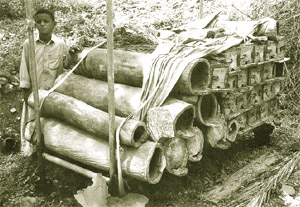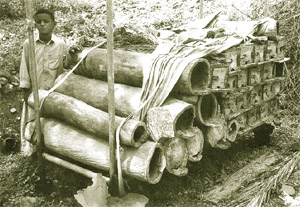
Bee-keeping in Yemen [Archives:2001/52/Reportage]
December 24 2001
Julian Lush
The British-Yemeni Society Journal

One thing manifest over the whole route was the burgeoning of bee-keeping in Yemen. Stacks of bee-hives appear by the roadside all over the country, from small banks of half a dozen or so to large arrays of dozens – veritable apiaries. Clearly the profitable niche market traditionally held by the Wadi Duan and Tihama honey producers is being tapped by a great many others; why not, when the bees, who do the essential work, are free to all?
We saw hives on the road to Manakha, in the plains east of Sanaa and in Marib, in Wadis Beihan, Yahbum, Hadramaut and Duan and in the Hujjariyah and Tihama; and they are doubtless to be seen elsewhere.
Bees have been social insects for 10-20 million years and have had time to develop varieties adapted to many localities. The variety of honey-bee endemic to Yemen is the apis Yemenitica – a small, dark bee which thrives in the hot, dry conditions. Traditional bee-keeping methods using a long, thin hive-box hollowed from a log can still be seen. Modern hive-boxes, based on the same principle, are wooden, 80-100 cm long and 12×12 cm in cross-section. The front has a hinged door with a V-shaped bee entrance, and the rear closure is plugged and sealed with mud. Alternatively, as we observed in the suq at Seiyun, hibes can be of pottery pipe, made in three sections and supported on a metal frame, enabling the hive to be opened at two points in its length.
In all these long hives, the queen and brood generally inhabit the front of the hive, while the honey combs, naturally built by the bees in parabolic shape, are suspended longitudinally for maximum ventilation and cooling. The honey comb is extracted through the rear of the hive which is sealed with mud and thus easily opened, causing minimum disturbance to the brood (larvae and developing bees) inside.
Apiaries are in banks of 10-100 hives, stacked 3-4 rows high on a metal stand, covered by grass or similar cooling material, which in turn is covered over with a blue plastic sheet. One is struck by the extreme proximity of the hives to one another, and by the amazing ability of bees to know which is home.
The favorite forage of the Yemenitica bee is from the flowering al-sidr tree or ziziphus spina-christi, the kasas, a Euphorbia, and from acacia trees, all of which are found throughout the country. But the bees are not particularly choosy and will glean pollen and nectar from a surprising range of plants even in arid regions. However, their forage may not be plentiful at all seasons, and Yemeni bee-keepers supplement their diet with sugar. Water also has to be available at all times, for this is essential for the bees health and the honey-making process.
To gauge the pace of bee-keeping development, I asked a hive maker in Bait al-Faqih what his production and sales rates were. He said that he was selling 700-800 box-hives per month at a price of YR 600 (3 sterling pounds) each; by contrast, log hives cost YR2000 each. His market covered just one part of the Tihama. If the rates which he quoted are extrapolated over the rest of the country, one can see the likely scale of the growing industry.
A timely local press article provided some statistics on Yemen honey production, stating that Hadhrami honey led the field (as expected) with 35 tons per year, a large proportion of which is exported to other Arab countries (where it command huge prices.) Next comes Shabwa Government with 29 tons annually, followed by Mahwit with 15 tons, Tihama with 13 tons, Hajjah with 8 tons, Osaimat, Ibb and Taiz with 4-5 tons each, and around 35 tons from other areas, making a total production of some 150 tons a year. The article adds that a kilogram of good honey sells for $150, hence the real attraction of bee-keeping in Yemen: no amateurs there!
——
[archive-e:52-v:2001-y:2001-d:2001-12-24-p:./2001/iss52/report.htm]


